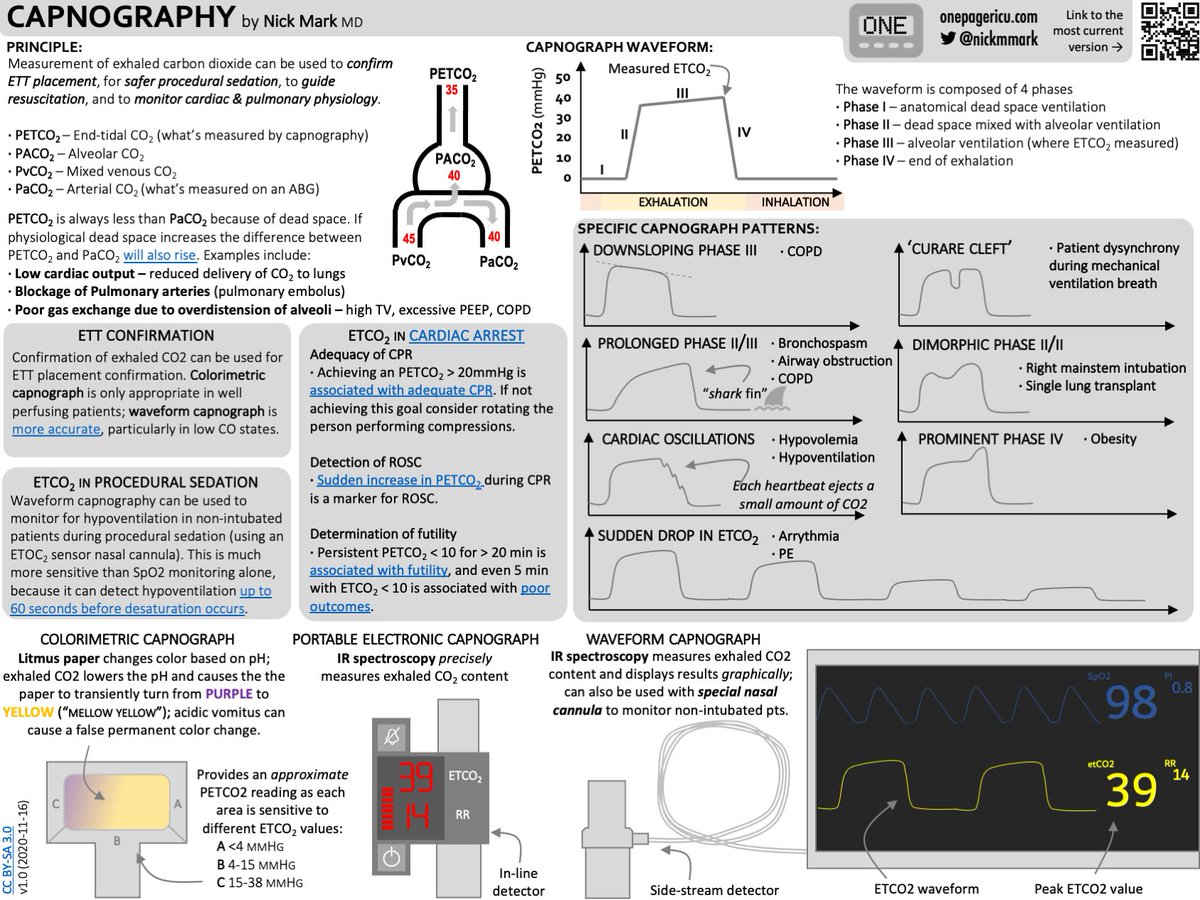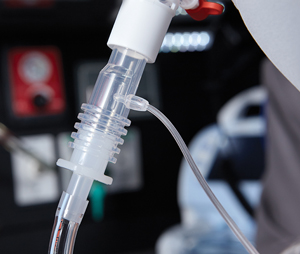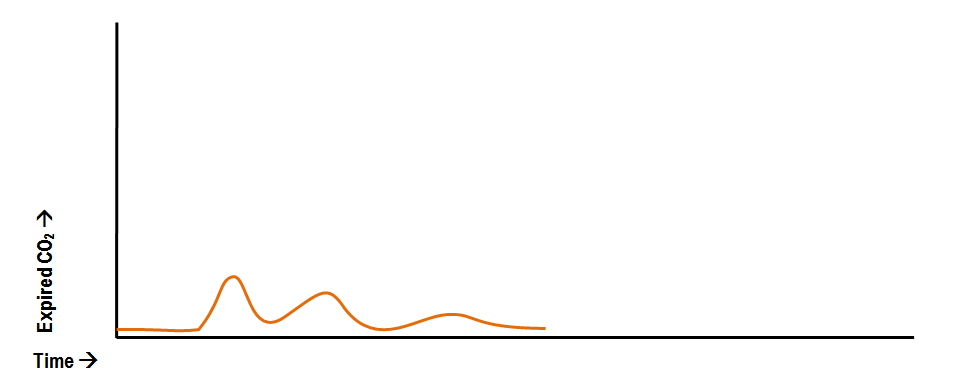low end tidal co2 after intubation
Colorimetric etco2 is a safe reliable simple and portable tool to determine the proper placement of endotracheal tube in patients with stable. Effect of epinephrine on the ability of end-tidal carbon dioxide readings to predict initial resuscitation from cardiac arrest.

Emergency Intubations Capnography
Negative Epigastric sounds Equal lung sounds Esophageal detector End tidal CO2 detector Secondary signs.

. The hinges represent the first and third quartiles the notches represent the 95 confidence interval CI of the median and the whiskers extend to 15 interquartile range. Capnograph is an indispensable tool for monitoring metabolic and respiratory function. 2 verification of the correct positioning.
A semiquantitative colorimetric FEF end-tidal CO2. Association between prehospital cpr quality and end-tidal carbon dioxide levels in out-of-hospital cardiac arrest. Low end tidal co2 after intubation Thursday March 10.
Asplin BR White RD. Conversely if the patient has low co2 perhaps because of hyperventilation it will cause an increased affinity for oxygen allowing hemoglobin. Other reasons C02 may be low.
Also called capnometry or capnography this noninvasive technique provides a breath-by-breath analysis and a continuous recording of ventilatory status. After intubation if ETCO 2. Crit Care Med 1992.
First 20 minutes after intubation was. Cardiac arrest decreased cardiac output hypotension cold severe pulmonary edema. 78 Nitrogen 21 Oxygen 1 CO2 and other gases Exhaled gases.
EtCO2 is a measurement of the partial pressure of CO2 in gas expired at the end of exhalation when exhaled gas will most closely resemble the alveolar CO2 concentration. Confirming Maintaining and Assisting Intubation Continuous End. NaHC03 will increase EtCO2 because it splits into CO2 and H20 So if rises after NaHCO3 do not misinterpret as ROSC Vasopressors will decrease ETCO2 they cause high afterload increasing BP and myocardial blood flow but a.
Maximum end-tidal carbon dioxide Et co 2 within 5 minutes of the onset of mechanical ventilation in the operating room ORBox plot with data points overlaid. June 2002 - Volume 94 - Issue 6 - p 1534-1536. Normal ETCO2 in the adult patient should be 35-45 mmHg.
End tidal carbon dioxide ETCO 2 monitoring is a more objective method812 and is recommended as the best method to confirm correct ETT placement by the 2015 International Consensus on Cardiopulmonary Resuscitation13 In a study of 100 intubation episodes 39 of 40 oesophageal intubations. 1 surveillance et monitoring of the intubated patient. The alpha angle is the transition from Phase II to Phase III.
Life like end-tidal CO2 production has been reported in frozen cadaver during intubation training. Am J Emerg Med 1996. Total pressure of a gas is the sum of the partial pressures of the gas Expired CO2 measured PetCO2 mmHg in waveform Percentage Normal Levels PaO2 85-100mmHg PaCO2 35-45mmHg Percentage vs.
I present the case of a 52-yr-old man who likely died from an unrecognized esophageal intubation after the induction of general anesthesia. The goal should be to maintain ETCO2 no lower than 10-20 mmHg. Prediction of outcome of CPR from end-tidal carbon dioxide concentration.
End-tidal carbon dioxide changes during cardiopulmonary resuscitation after experimental asphyxial cardiac arrest. Bhende MS Karasic DG Karasic RB. A low end-tidal CO2 may indicate poor perfusion hypovolemia or sepsis.
Waveform capnography should be monitored in all intubated patients and displayed on the monitor as above. In this study the aim was to review the applications of end-tidal carbon dioxide ETCO2 monitoring in emergency department multiple databases were comprehensively searched with combination of following keywords. An ETCO2 below 10 mmHg is associated with poor outcome.
Confirming Maintaining and Assisting Intubation Continuous End Tidal CO2 monitoring can confirm a tracheal intubation. ETCO2 is one valuable tool we have to tell us that good quality compressions are being delivered. Prognostic value of end-tidal carbon dioxide pressures during out-of-hospital cardiac arrest.
This will cause a decrease in the ETCO2 end-tidal CO2 and this will be observable on the waveform as well as with the numerical measurement. End-tidal CO2 measurement in the detection of esophageal intubation during cardiac arrest. A low P a CO2 level is correlated with increased risk of cerebral edema in children with DKA.
In fact its commonly called the ventilation vital sign. The number is called capnometry which is the partial pressure of CO 2 detected at the end of exhalation ranging between 35 - 45 mm Hg or 40 57 kPa. MEASURING END-TIDAL CO 2 LEVELS DURING CARDIAC ARREST.
A prospective clinical trial was conducted at a level I trauma center to assess the efficacy of end-tidal carbon dioxide CO2 detection in four groups of patients requiring emergency intubation because of cardiac arrest major trauma respiratory failure or the need for airway protection. Murphy RA Bobrow BJ Spaite DW et al. Prediction of outcome of CPR from end-tidal carbon dioxide concentration.
Callaham M Barton C. Two very practical uses of waveform capnography in CPR are. End-tidal carbon dioxide ETco 2 monitoring provides valuable information about CO 2 production and clearance ventilation.
The higher the ETCO2 measured during compressions the better the perfusion being supplied by CPR. Callaham M Barton C Mathay M. 1 evaluating the effectiveness of chest compressions and 2 identification of ROSC.
End-tidal carbon dioxide reflects CO 2 concentration of alveoli emptying last. Ann Emerg Med 1995. Normal ETCO2 in the adult patient.
What is end-tidal CO2 etCO2. This will cause a decrease in the ETCO2 end-tidal CO2 and this will be observable on the waveform as well as with the numerical measurement. Carbon dioxide CO 2 along with oxygen O 2 share the role of being the most important gases in the human bodyThe measuring of expired CO 2 at the mouth has solicited growing clinical interest among physicians in the emergency department for various indications.
The depth of the tube for a male patient on average is 21-23 cm at teeth The depth of the tube on average for a female patient is 19-21 at teeth. 11172009 4 Measuring End Tidal CO2 Daltons Law. Confirm ETT placement with end-tidal CO2 detector bilateral breath sounds and chest rise.
A low end-tidal CO2 in hypothermia. Crit Care Med 1990. MmHg Relate to the air we breath.
We report the same phenomenon in a non-frozen cadaveric model used to undertake CT postmortem with the additional findings of an increase in CO2 with chest compressions and an increase in CO2 after a pause in ventilation. This case was notable for a normal end-tidal carbon dioxide tracing after intubation. B beige indicates moderate levels and probable tracheal intubation.
ETCO2 emergency department monitoring and critical. An end-tidal carbon dioxide level of 10 mmHg or less measured 20 minutes after the initiation.

3 Waveform Capnography Showing Changes In The End Tidal Carbon Dioxide Download Scientific Diagram

3 Things To Know About Capnography And Advanced Airways Capnoacademy Capnoacademy

Waveform Capnography In The Intubated Patient Emcrit Project

Abnormal Capnography Waveforms And Their Interpretation Deranged Physiology

Waveform Capnography In The Intubated Patient Emcrit Project

Basic Capnography Interpretation Nuem Blog

What S In A Wave Form Utilizing End Tidal Capnography For More Than Intubation Confirmation Criticalcarenow

Waveform Capnography In The Intubated Patient Emcrit Project

Reversible Causes Of Low Etco2 In Cpr Criticalcarenow

Abnormal Capnography Waveforms And Their Interpretation Deranged Physiology

Waveform Capnography In The Intubated Patient Emcrit Project

Nick Mark Md On Twitter End Tidal Co2 Monitoring Capnography Is An Important Technique To Guide Resuscitation Confirm Ett Intubation Monitor Physiology Make Procedural Sedation Safer Here S A New1 Onepager All About

Etco2 Valuable Vital Sign To Assess Perfusion The Airway Jedi

The Impact Of Ventilation Rate On End Tidal Carbon Dioxide Level During Manual Cardiopulmonary Resuscitation Resuscitation

Waveform Capnography In The Intubated Patient Emcrit Project

Potential Applications Of Capnography In The Prehospital Setting Journal Of Paramedic Practice

Waveform Capnography In The Intubated Patient Emcrit Project

